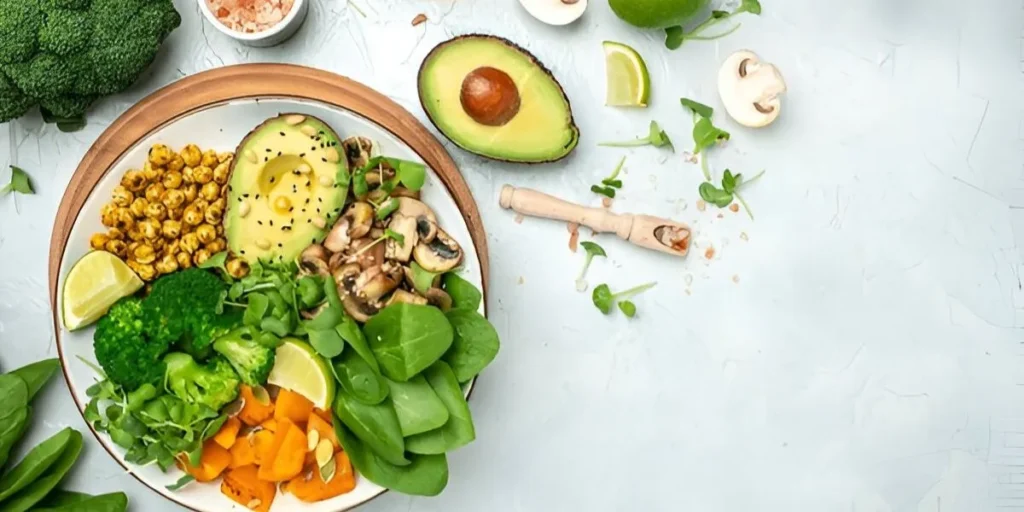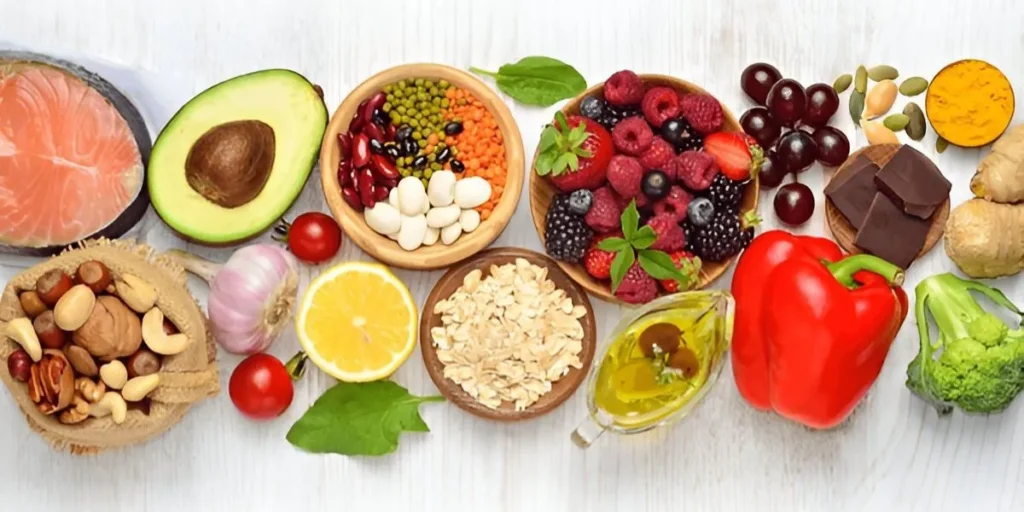Healthy Nutrition Guide: Everything You Need To Know
Healthy nutrition affects how you feel and live every day. This guide explains the science of eating well. It shows how small changes can lead to big health benefits.
It’s not about strict rules. It’s about eating the right foods for lasting energy and vitality. Learn to avoid diet myths and focus on real, sustainable habits.
Discover how nutrients like proteins, vitamins, and fiber support your goals. Whether you’re busy or aging, this guide offers practical steps. It helps you build a personalized plan.
Key Takeaways
- Healthy nutrition improves energy, mental focus, and disease resistance.
- Focus on whole foods instead of quick fixes for long-term benefits.
- Your body needs a mix of macronutrients and micronutrients daily.
- Adjusting eating habits to life changes ensures consistent progress.
- Understanding food labels helps you avoid hidden sugars and additives.
Understanding the Foundations of Healthy Nutrition
Healthy eating begins with the basics. A balanced diet gives you the nutrients you need. Holistic nutrition looks at how food affects your overall health. Let’s explore these ideas to start your health journey.
What Defines a Nutritious Diet
A nutritious diet has the right mix of proteins, carbs, fats, vitamins, minerals, and fiber. Your body needs these to work well. But, how much you need changes based on your age, how active you are, and your health goals.
- Proteins help fix tissues and keep your immune system strong.
- Complex carbs give you energy without making your blood sugar go up too high.
- Healthy fats help your brain work better and help you absorb nutrients.
There’s no one diet that fits everyone. Your diet should change as your life does.
The Mind-Body Connection in Nutrition
“What you eat directly impacts how you think and feel.”
Studies show that omega-3s can improve your mood. On the other hand, too much sugar can make you feel tired. Holistic nutrition sees food as more than just calories. It’s fuel for your brain and emotional well-being.
Choosing foods like leafy greens or nuts helps your brain and body. If you’re stressed, foods high in magnesium or B vitamins might help control stress hormones naturally.
The Difference Between Dieting and Healthy Eating

Diets often cut calories or certain foods for quick weight loss. But, this can lead to cravings, frustration, and failure. Healthy eating is about making lasting changes:
- Eat whole foods like fruits, vegetables, and lean proteins.
- Pay attention to when you’re hungry instead of following strict rules.
- Try different foods to avoid missing out on nutrients.
A balanced diet is not just for now. It’s a way to care for your body for the long term, without extremes.
The Science-Backed Benefits of Proper Nutrition
Proper nutrition is more than just counting calories. It’s a science-backed way to improve your health. A study in the New England Journal of Medicine found that a balanced diet can cut your risk of chronic diseases by up to 50%. Eating whole foods helps your body work at its best.
- Heart health: Foods high in omega-3s and fiber can lower bad cholesterol, as studies from the American Heart Association show.
- Brain function: B vitamins and antioxidants improve focus and memory. Research links Mediterranean diets to slower brain aging.
- Immune strength: Vitamin C and zinc help fight off infections. NIH-funded trials found a 30% reduction in infections with these nutrients.
| Benefit | Key Nutrients | Study Reference |
|---|---|---|
| Reduced diabetes risk | High-fiber, low-glycemic foods | Harvard T.H. Chan School of Public Health (2022) |
| Improved mental health | Omega-3s, magnesium | Journal of Clinical Psychiatry (2021) |
| Stronger bones | Vitamin D, calcium | National Osteoporosis Foundation |
A wellness lifestyle based on nutrition also boosts energy and sleep. Iron-rich foods improve oxygen flow, while magnesium helps you relax. These changes lead to long-term health benefits.
Science reveals that 80% of chronic illnesses can be prevented with diet. By making these changes, you’re investing in your future health. Your choices today impact your physical and mental well-being, embodying a true wellness lifestyle.
Essential Nutrients Your Body Needs Daily
Your body needs specific nutrients every day. Each one helps you stay energized, strong, and healthy. Making sure you get these nutrients is key to fueling your body right.
Macronutrients: Proteins, Carbs, and Fats
Macronutrients are the main parts of your diet. Focus on getting high-quality sources:
- Proteins: You can find them in chicken, fish, beans, and tofu. They help fix tissues and build muscles.
- Carbohydrates: Go for whole grains like quinoa or oats for lasting energy. Avoid refined sugars.
- Fats: Avocados, nuts, and olive oil are full of omega-3s. They also protect your organs.
Vital Micronutrients: Vitamins and Minerals
Vitamins and minerals are like your body’s maintenance team. For instance:
- Vitamin C in citrus fruits boosts your immune system.
- Calcium in dairy or leafy greens makes your bones strong.
- Zinc in nuts helps with wound healing.
Eat nutrient-dense foods like spinach or almonds to meet these needs well.
Hydration as a Cornerstone of Healthy Nutrition
Water does more than just quench thirst—it’s vital for every cell. Drink 8-10 cups a day, depending on how active you are. Use water, herbal teas, or foods like watermelon to stay hydrated. Even a little dehydration can make you tired or give you headaches.
Fiber and Its Role in Digestive Health
Fiber keeps your digestive system working well. Nutrient-dense foods like oats (soluble fiber) and broccoli (insoluble fiber) are great. Start with small amounts to avoid discomfort and drink enough water.
Building Your Personalized Healthy Nutrition Plan

Creating a sustainable healthy nutrition plan starts with knowing your needs. Follow these steps to make a plan that fits your lifestyle and goals.
Assessing Your Current Eating Habits
Start by tracking your food for 3–5 days. Use apps like MyFitnessPal or a journal to note what you eat. Look for patterns, like skipping breakfast or eating too much sugar.
- Track meals without judgment to avoid overwhelm.
- Identify nutrient deficiencies (e.g., fiber, vitamins).
- Notice how certain foods affect your energy levels.
Setting Realistic Nutrition Goals
Goals should be clear and doable. Instead of “eat better,” aim for:
- Replace one sugary drink daily with water.
- Add a serving of leafy greens at lunch and dinner.
- Cut processed snacks by 50% in two weeks.
Small changes lead to big results. Celebrate your wins to stay on track.
Adapting Your Plan for Different Life Stages
“Nutritional needs change with life—like managing stress, expecting a child, or aging—so your plan must evolve,” says the Academy of Nutrition and Dietetics.
During pregnancy, focus on folic acid and iron. For aging adults, prioritize calcium and vitamin D. Adjust calories as your activity level changes. A dietitian can help during big life changes. Being flexible keeps your balanced diet in line with your health goals.
Incorporating Whole and Nutrient-Dense Foods

Choosing whole foods means picking items that are not heavily processed. Look for fresh veggies, unprocessed grains like oats or quinoa, and fruits instead of packaged snacks. These foods are full of vitamins, fiber, and antioxidants without added sugars or artificial additives.
Begin by switching from refined grains to whole grains. Use brown rice or farro instead of white rice in stir-fries. Choose oatmeal with berries instead of sugary cereals. For proteins, go for legumes like lentils or chickpeas and lean meats when you can.
Keep frozen veggies handy for quick meals. They keep nutrients and save time.
- Stock your pantry with bulk bins: grains, nuts, and seeds.
- Buy seasonal produce at farmers’ markets or discount bins for affordability.
- Prep in batches: chop vegetables or cook grains ahead for weekday meals.
“Whole foods aren’t about perfection—they’re about progress. Small swaps add up over time,” says registered dietitian Sarah Thompson, author of *Eat Real Food*.
Worried about cost? Beans are cheaper than meat, and frozen fruits are as nutritious as fresh ones. Plan your meals to avoid takeout. Even adding an extra veggie to your meals helps without feeling overwhelmed.
Clean Eating: Beyond the Buzzword
Choosing clean eating means understanding food choices. It’s about avoiding marketing tricks. Here’s how to make better, healthier choices.
Reading Food Labels Effectively
Flip the package over. Look for short ingredient lists with names you know. Avoid products with sugar or sodium first. These are listed by quantity.
Watch for phrases like “no artificial additives.” But always check the list to confirm.
- Focus on total sugar content, not just added sugars
- Choose products with fewer than five ingredients
- Opt for items with organic ingredients when pesticides are a concern
Identifying Hidden Sugars and Additives
Manufacturers often hide sugar under 61+ aliases. Here’s what to watch for:
| Alias Names | Examples |
|---|---|
| Syrups and -oses | Corn syrup, maltose, dextrose |
| Unrefined sweeteners | Coconut sugar, agave nectar |
| Additive identifiers | Anything with “carrageenan,” “BHA,” or “TBHQ” |
The Organic vs. Conventional Debate
Organic ingredients aren’t always needed—but sometimes they are. Consider these factors:
| Factor | Organic | Conventional |
|---|---|---|
| Pesticide levels | Lower residues per USDA standards | May contain allowable pesticide residues |
| Cost | 10-30% higher price | More accessible budget-wise |
| Environmental impact | Soil health benefits | Higher yield potential |
A
2022 Harvard study
found organic produce offers modest nutritional benefits. It suggests choosing whatever encourages more vegetable consumption.
Mixing conventional and organic choices based on the EWG’s Dirty Dozen list can balance cost and safety. Clean eating isn’t about being perfect—it’s about making progress.
Practical Tips for Maintaining Healthy Nutrition on a Budget
Eating well doesn’t have to cost a lot. With some planning, you can eat healthy without spending too much. These tips help you eat right while keeping your budget in check.
Meal Prepping Strategies for Busy Lifestyles
Batch cooking saves time and reduces waste. Here’s how to do it:
- Cook in bulk: Make big batches of grains like brown rice or quinoa for the week.
- Prep versatile bases: Roast veggies or grill chicken for salads, wraps, or stir-fries.
- Store smartly: Use airtight containers to keep meals fresh for 3–4 days.
Seasonal Shopping to Maximize Nutrition and Savings
Buying produce in season saves money and tastes better. Here’s what to look for by season:
| Season | Top Picks |
|---|---|
| Spring | Asparagus, strawberries, peas |
| Summer | Berries, corn, tomatoes |
| Fall | Squash, apples, Brussels sprouts |
| Winter | Citrus fruits, root vegetables |
Look for deals at local farmers’ markets or stores like Aldi on in-season items.
Smart Choices When Eating Out
Eating out doesn’t mean you have to give up on healthy eating. Here’s how to make smart choices:
- Choose grilled or baked dishes over fried ones.
- Ask for healthier options: Swap fries for a salad or steamed veggies.
- Split meals to avoid overeating and save money.
“Choosing nutrient-rich meals outside the home reinforces the principles of a balanced diet without overspending,” says the USDA’s dietary guidelines.
By using these strategies, you can eat well on any budget. It’s all about planning and making smart choices.
Common Nutrition Myths and Misconceptions Debunked

Sorting through nutrition advice can be tricky. Many myths confuse the truth, making it tough to know what to believe. Let’s clear up four myths that science has proven wrong—and how they impact your choices.
- Myth: Eating carbs leads to weight gain. Fact: Carbs are your body’s main energy source. It’s the type that matters: whole grains, fruits, and veggies are better than refined sugars and processed snacks.
- Myth: Plant-based diets lack protein. Fact: A well-planned plant-based diet gives you all the amino acids you need. Beans, lentils, tofu, and whole grains provide enough protein without animal products.
- Myth: Supplements replace whole foods. Fact: Pills can’t match the mix of nutrients in real food. Vitamins and minerals work best when they come from natural sources.
- Myth: All plant-based diets are automatically healthy. Fact: A diet of fries and soda might be plant-based but is very unhealthy. Stick to whole foods like veggies, legumes, and whole grains.
“A varied plant-based diet can support all life stages, but it requires intentional planning,” according to a 2023 Harvard School of Public Health review.
Marketing often makes nutrition seem too simple. Ask yourself: Is this advice based on solid studies? Does it consider my unique needs? Trust sources like USDA guidelines or registered dietitians over viral trends. Science shows myths spread fear and misinformation. Knowing the facts helps you avoid these traps and make better choices.
Conclusion: Embracing Healthy Nutrition as a Lifestyle
Healthy nutrition isn’t about strict rules. It’s a base for a lasting wellness lifestyle. This guide showed how to make habits that fit your needs. Focus on making consistent choices that match your goals, whether it’s balancing your schedule or enjoying special times.
Life changes are normal. Travel, holidays, or stress shouldn’t stop your progress. Carry healthy snacks, pick restaurants with whole foods, and drink plenty of water. Mindfulness helps you make better choices, and seeing setbacks as learning moments builds strength. Your relationship with food should grow, not stay the same.
Stay updated to keep your approach current. Follow trusted sources like USDA guidelines or scientific studies. Small daily changes, like choosing fresh fruit over processed snacks or cooking in batches, make a big difference. Healthy nutrition works best when it’s adaptable, not about being perfect.
Every choice counts. Whether it’s packing lunches, reading labels, or enjoying treats now and then, aim for balance. A wellness lifestyle is about nourishing your body, not restricting it. By using the tips from this guide, you’ll create a strong connection to nutrition that supports your health and well-being.









